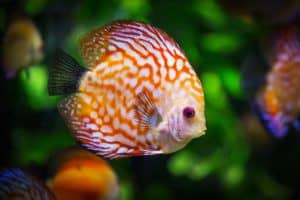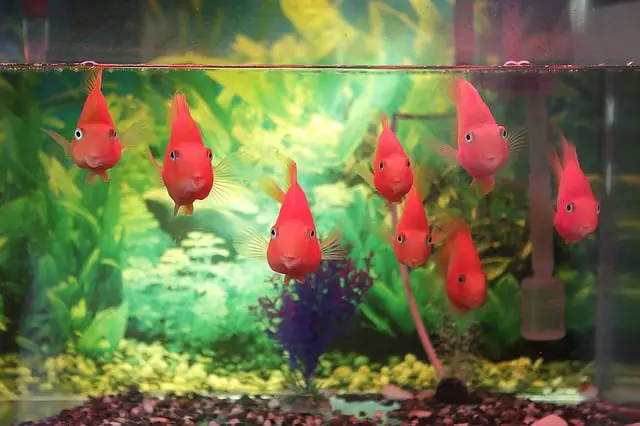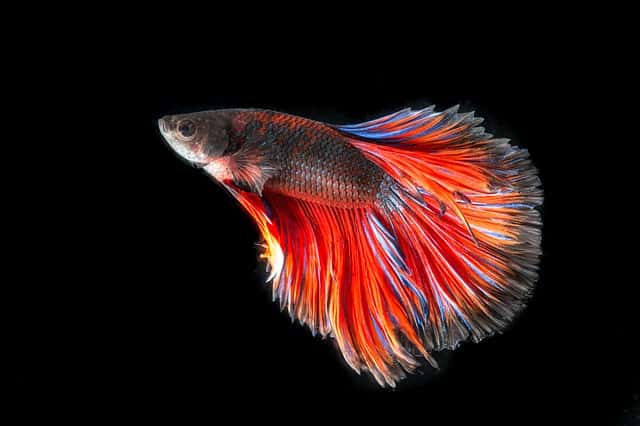The ecosystem in an aquarium really is an amazing place! It is also very easy to disrupt and make the environment deadly for your fish if you are not knowledgeable in a few areas of the tank. The Nitrogen cycle is an extremely important part of your aquarium running safely and efficiently. Knowing and understanding where beneficial bacteria resides in the tank is another extremely import part of having a healthy tank.
Where is Beneficial Bacteria in Aquarium? The beneficial bacteria in an aquarium resides in the filtration system as well as the substrate, plants, decorations and the inside walls (glass or acrylic) of the tank. Beneficial bacteria is not in the water itself, as some hobbyists may think.
Understanding where the beneficial bacteria lives in your tank will determine whether you have a healthy aquarium or not. Once you understand what does (and doesn’t) affect it, you will then know what it takes to have happy and healthy fish.
What is Beneficial Bacteria in Aquariums?
I will give you the high-level explanation of what aquarium bacteria is, as I have a really in-depth article on the nitrogen cycle that explains this. Having your tank run through the nitrogen cycle is how the bacteria is formed. Here is how the bacteria comes to be in your tank.
- Under normal circumstances your tank has filtration running and fish living inside it. The fish will poop and fish will miss eating all of the food at times. The poop and the food will fall to the substrate. If you have live plants and any die or leaves and branches fall off and fall to the bottom of the tank, this will also start the process.
- When these types of things happen a process kicks off with ammonia appearing. Ammonia can be deadly to your fish if left untreated. When the ammonia appears, bacteria starts to grow which converts the bad ammonia to nitrite and is toxic for your fish.
- Now that nitrite is appearing more bacteria grows and is being converted again to nitrate. Nitrate is much less toxic to fish however should still be taken out of the tank. The best and easiest way to get nitrate out of the aquarium is to do regular water changes.
Where is the Beneficial Bacteria in My Aquarium?
- Bacteria is not residing in the water of your tank if that’s what you are thinking. You can find bacteria covering decorations and plants. It can be found in the substrate and sticking to the inside walls of your aquarium. It can also be found in the filtration system. It will be found growing in bio balls or sponge inserts as well on the inside of the body of the filtration system.
- Having said that, this is why when you clean your filter media, you should use water from the tank to rinse it out in. If you use tap water, all of the bacteria will be washed away and die off. If you use tank water, the bacteria that is left on the filter parts will still be alive and healthy.
- If you do any cleaning in the tank where you are scrubbing the inside glass or acrylic walls or siphoning up the substrate you are removing bacteria and there could be spikes in ammonia and nitrite.
- It is recommended to test the water parameters a day or two after doing a good cleaning on the tank. If you want to minimize the size of spikes with the waters parameters you should alternate when you clean the different parts of the tank. Do gravel one week, glass and decorations every other week and filter every 5 to 6 weeks as required.
How Long Does it Take for Bacteria to Grow in an Aquarium?
The answer depends on what route you take to grow bacteria in the tank. There are a couple of good ways to make this happen.
- The quickest way to grow bacteria is to use filter media or substrate from a running healthy tank. Place it into your new setup and you could have a healthy ammonia and nitrite free aquarium in as little as 2 weeks.
- If you have time to spare setting up a new tank and letting nature take course it will take approximately 4 to 6 weeks for the water parameters to be where they should be. To speed it up put a bit of fish flake food in the tank. The food will start to decay kicking off the growth of ammonia.
How to Get Beneficial Bacteria into an Aquarium?
We have answered this question above. Another option is to purchase bacteria in a bottle and add it to the tank. Some hobbyists swear by this method and others shy away from it, unsure if the bacteria is indeed quality.
What I would say to the potential quality issue is that the purchased bacteria is only to get the water parameters where you need them to be to start adding fish. Once you add fish and there is poop and excess food etc. will be more bacteria growing. So even if the bacteria in the bottle wasn’t premium it will be, once the aquarium is up and running.
Is There Bad Bacteria in a Fish Tank
There is bad bacteria from time to time in an aquarium. Mostly though if you’re running a healthy tank you shouldn’t have bad bacteria. Bad bacteria will affect fish when they are sick or wounded. The bad bacteria will speed up and make the ailing issue worse for fish.
The best way to fight this is through regular tank maintenance and to make sure you have a sick tank running for emergencies.

Can you add too Much Bacteria to a Fish Tank?
If you are adding a bottled bacteria I would say no. I feel that most likely any excess bacteria would just die out.
How Do I Get Rid of Bacteria in My Fish Tank?
I am not sure why you would want to get rid of bacteria in your fish tank. If you must do this then we covered it above when talking about cleaning the tank. If you want to get rid of beneficial bacteria just do some cleaning. Siphon the substrate, clean the walls and filter. This should get rid of the majority of the bacteria in the tank.
How Long Does it Take for Bacterial Bloom to Go Away?
Bacterial bloom is when the water goes cloudy usually during a nitrogen cycle. The cloudiness will go away once the ammonia and nitrite clear up. Anywhere from 2 to 6 weeks.
If your tank goes cloudy after it is established then you probably have too much poop and debris in the tank. It is then time for a big water change and cleaning. Make sure to do this in stages so as not to spike the ammonia and nitrite levels even more.
Best Aquarium Bacteria Supplement
Crowning the best bacteria starter for your aquarium would be difficult as many users will prefer different aspects of different products. What I can tell you though is that the Tetra SafeStart Plus concentrated aquarium bacteria starter will do the job.
Tetra claims that after adding this supplement to the water you can add fish immediately. I would caution you on doing this as every set-up is different and some fish are less tolerable than others. If there are any random spikes of ammonia and nitrite, your fish could die, especially if the tank is small then the effects would be quicker.
What I recommend is using this product because it does work but I would suggest that you wait exactly 1 week after adding it to the water. Test the water after a few days to see where the parameters are at and then on the 7th day to see if the ammonia and nitrite readings are showing a zero.
There are many aquarium water test kits available. Most work very well. If you want a recommendation I would go with the API Master Test Kit. You will get tests for Ammonia, Nitrite, Nitrate as well as PH. That’s all you need when you are just starting out. These tests are very accurate and very popular.
Conclusion
As you can see having bacteria in your aquarium is necessary for a healthy environment. It is required for all of the living creatures behind those glass walls. Remember that:
- Performing regular water changes is required and important. Taking water out removes nitrates and some waste and debris. Water changes alone should not cause a spike in ammonia or nitrite. Use reverse osmosis water if possible.
- Cleaning your filter materials with tap water will kill beneficial bacteria. Use water from the tank to clean out filter media.
- Alternate cleaning the substrate and filter as doing these cleanings will remove some of that good bacteria. Too much good bacteria removed will cause you issues.
- Test the water parameters on a regular basis especially a day or two after cleaning and water changes.
Related Posts
Aquarium Set Up for Beginners.






